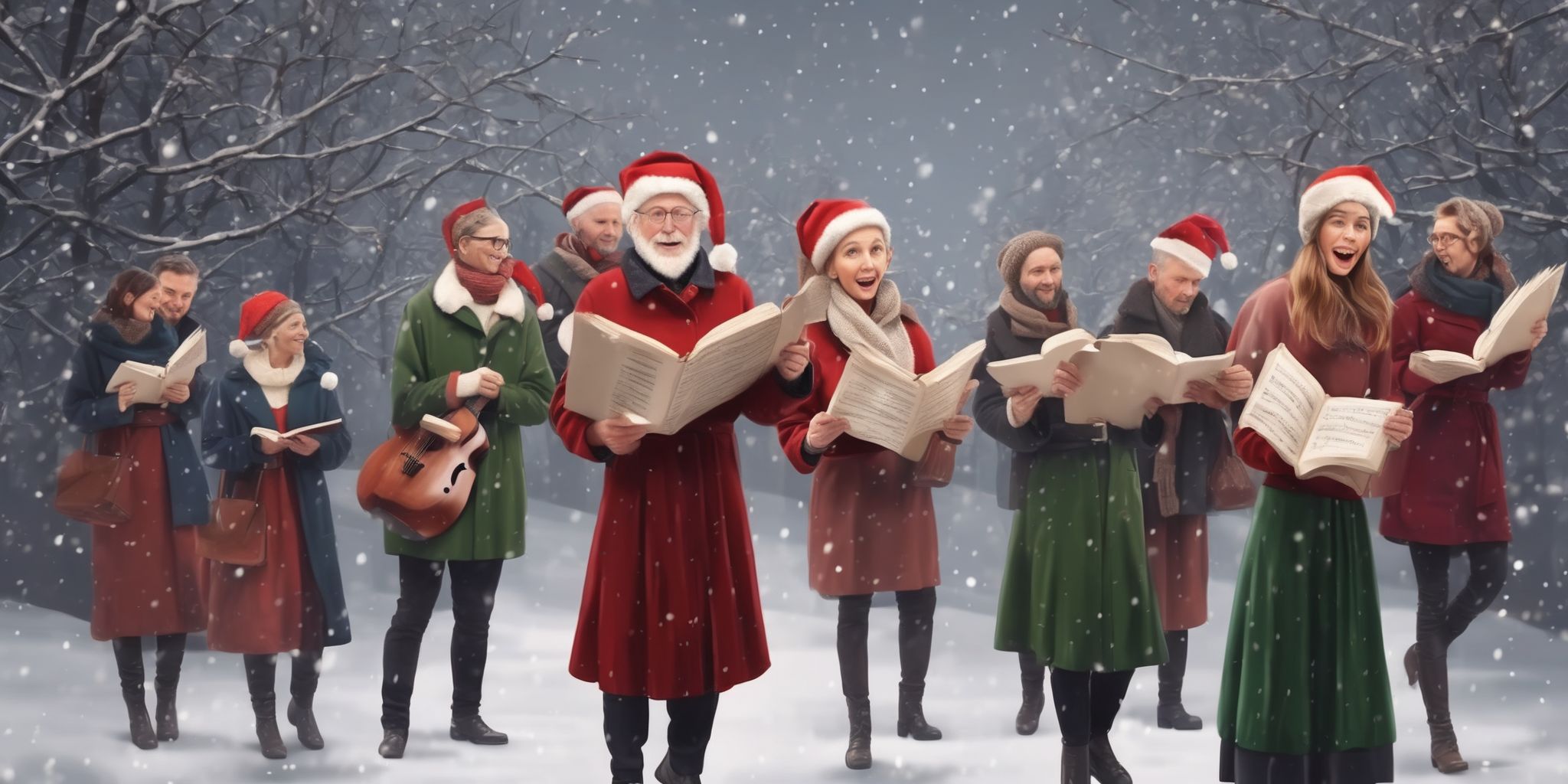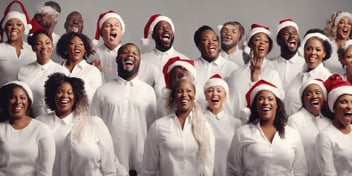
Ah, the cheerful jingles of Christmas music! It's that time of the year when the radio waves transform into a melodious wonderland, filled with the joyful tunes that have defined the holiday season for centuries. From traditional carols that echo through church pews to modern-day pop renditions, Christmas music has become an integral part of our holiday celebrations.
But have you ever wondered about the captivating history and diverse origins behind these festive melodies? Join us on an enchanting journey as we unwrap the stories and traditions that have shaped the rich tapestry of Christmas music throughout time. Get ready to dive into the heartwarming origins of your favorite carols and discover surprising new holiday songs from around the globe. So, let the sleigh bells ring, and the harmonies soar as we embark on a melodic exploration of the fascinating world of Christmas music.
The Origins of Christmas Music
Early Christian Chants and Hymns
Early Christian chants and hymns laid the foundation for Christmas music. These ancient melodies, passed down through generations, continue to influence and inspire composers today. The use of plainchant in early Christian liturgy set the tone for somber and contemplative Christmas music. The Gregorian chant, with its monophonic structure and modal scales, guided the development of sacred Christmas hymns. The melody of "Ave Maria," for example, can be traced back to these early Christian chants.
By understanding the origins of Christmas music, composers can create meaningful and authentic compositions that resonate with audiences throughout the holiday season.
The Influence of Folk Music and Traditional Carols
Folk music and traditional carols have a strong influence on Christmas music. These timeless melodies and lyrics connect people with the traditions and history of the holiday season. Incorporating these elements in your own Christmas music can create a sense of nostalgia and familiarity that resonates with listeners.
For example, incorporating folk instruments like the acoustic guitar or harmonica can add a rustic and intimate feel to your songs. Traditional carols, such as "Silent Night" or "Deck the Halls," can serve as a foundation for new compositions, providing a recognizable and comforting structure. Embracing the influence of folk music and traditional carols can bring a classic touch to your Christmas music, capturing the spirit of the season.
The Advent of Christmas Music in Popular Culture
The inclusion of Christmas music in popular culture has become a cherished tradition, evoking a warm sense of nostalgia and holiday spirit. Here are some key insights into the advent of Christmas music:
- Christmas music serves as a powerful tool for establishing a festive atmosphere, creating a sense of joy and unity among listeners.
- It enables individuals to connect with their cultural and religious traditions, fostering a sense of belonging and identity.
- The popularity of Christmas music has led to an abundance of creative expressions across various genres, from classic carols to modern interpretations.
- Its widespread presence in commercials, movies, and public spaces demonstrates its effectiveness in captivating and engaging audiences.
- Christmas music has the capacity to invoke strong emotions and memories, making it a valuable tool for marketers and content creators to establish a deep connection with their target audience.
Christmas Music Around the World
Traditional Christmas Music in Europe
In Europe, traditional Christmas music holds a significant place in the festive celebrations. Here are some key features:
- Diversity: Each European country has its own unique traditional Christmas songs, bringing a diverse range of melodies and styles to the holiday season.
- Religious Influence: Many European Christmas songs have strong religious themes, reflecting the Christian origins of the holiday. These songs often focus on the birth of Jesus and the joy surrounding the Nativity story.
- Carols and Chants: Carols and chants are common forms of traditional Christmas music in Europe. They are often performed by choirs or sung by the community during festive gatherings.
- Instrumental Traditions: In addition to vocals, traditional European Christmas music embraces various instrumental traditions, including the use of bells, flutes, violins, and pipe organs.
- Folklore and Legends: Some countries incorporate folklore and legends into their Christmas music, adding a touch of myth and magic to the festive atmosphere.
- Resonance in Modern Culture: Despite evolving music preferences, traditional European Christmas music continues to resonate with people of all generations, inspiring nostalgia and a sense of cultural heritage.
The Carols of England
The Carols of England are a traditional form of Christmas music that have been embraced by people across generations. These songs, often sung in community gatherings or religious settings, serve as a nostalgic reminder of the holiday season. With their catchy tunes and simple melodies, they evoke feelings of joy and celebration. The Carols of England encompass a wide range of themes, from the birth of Jesus to the joys of wintertime.
Whether it's singing along to "Silent Night" or joining in a round of "Deck the Halls," these traditional carols bring people together and create a sense of unity during the festive season.
The Sacred Music of Italy
Italy has a rich tradition of sacred music that is deeply intertwined with Christmas celebrations. The sacred music of Italy adds a spiritual dimension to the festive season, enhancing the overall religious experience. From Gregorian chants to traditional hymns, this music creates a solemn and reverent atmosphere during Christmas Masses and services.
One example of this is the popular carol "Tu scendi dalle stelle" (You Came Down from the Stars), which originated in Italy and is sung during Christmas Eve Mass. The sacred music of Italy reminds us of the religious significance of Christmas and connects us to centuries-old traditions.
The Festive Songs of Germany
The festive songs of Germany play an integral part in Christmas celebrations. These songs are rich in tradition and instantly evoke a sense of holiday spirit. Carols like "Stille Nacht" (Silent Night) and "O Tannenbaum" (Oh Christmas Tree) are beloved classics that have stood the test of time. They are often sung at family gatherings, church services, and during festive events. The melodic tunes and heartfelt lyrics create a joyous atmosphere and bring people together during the holiday season.
These soulful songs have become an inseparable part of German Christmas traditions, spreading cheer and creating memorable moments for all.
Unique Christmas Music from Different Cultures
A unique aspect of Christmas music is its diversity across different cultures. Each culture has its own distinct traditions and styles of music associated with the Christmas season.
For example, in Latin America, there is a strong influence of traditional folk music, with melodies and rhythms reflecting the region's rich heritage. In Africa, Christmas music often incorporates local instruments and vocal harmonies, creating a vibrant and energetic sound. In Asia, traditional instruments such as the erhu or sitar may be used to give Christmas songs a distinctive flavor. Exploring the unique Christmas music from different cultures can broaden our musical horizons and provide a deeper understanding of the holiday's global celebration.
Latin American Villancicos
Latin American villancicos are an integral part of the region's Christmas music tradition. These festive songs, often characterized by their lively rhythms and catchy melodies, are performed during the holiday season in various Latin American countries. Villancicos typically blend religious themes with local customs and traditions, creating a unique cultural experience.
For example, in Puerto Rico, the Aguinaldo is a popular style of villancico that incorporates elements of African and Spanish music. In Mexico, the posadas are processions accompanied by villancicos that reenact Mary and Joseph's search for a place to stay. These joyful and celebratory songs are cherished by Latin Americans as they bring the spirit of Christmas to life.
African Drumming and Singing
African drumming and singing can inject energy and vibrancy into Christmas music. The rhythmic beats of African drums combined with soulful voices create a unique and captivating sound. Incorporating elements of African music into festive songs can add depth and cultural diversity, making the music more engaging and memorable.
For example, using traditional African percussion instruments like djembe drums or kalimbas can bring a distinct rhythm to Christmas carols.
Additionally, including call-and-response singing, a common practice in African music, can encourage audience participation and create a lively atmosphere during holiday performances.
Japanese Christmas Songs
Japanese Christmas songs are a unique blend of Western and Japanese influences. They are often sung in both English and Japanese, making them accessible to a wider audience. These songs are usually upbeat and catchy, with a focus on spreading joy and celebrating the holiday season. Some popular Japanese Christmas songs include "Last Christmas" and "Jingle Bells." These songs are commonly played in shopping malls, restaurants, and on the radio during the Christmas season in Japan.
Listening to Japanese Christmas songs can help add a festive touch to your holiday celebrations and introduce you to different cultural traditions.
Evolution and Contemporary Trends in Christmas Music
Transformation of Traditional Carols into Popular Hits
Traditional carols have undergone a transformation into popular hits, becoming a staple of the holiday season. This process is driven by the desire to appeal to a wider audience while maintaining the essence of the original carol. Artists often reimagine the melody, rhythm, and instrumentation to create a modern sound.
Additionally, the lyrics may be rewritten or tweaked to reflect contemporary themes.
For example, a carol about a winter wonderland may be modified to include references to smartphones or social media. This adaptation allows carols to resonate with younger generations while still invoking the festive spirit of Christmas.
The Rise of Contemporary Christmas Albums
In recent years, there has been a notable surge in the popularity of contemporary Christmas albums. This trend can be attributed to several factors:
- Adaptation to changing musical preferences: Contemporary Christmas albums cater to the evolving tastes of younger audiences, who seek modern renditions of holiday classics.
- Expanding the repertoire: Artists are creatively reimagining traditional Christmas songs and introducing original compositions, enticing listeners with fresh and innovative content.
- Broadening cultural inclusivity: Contemporary Christmas albums embrace diversity by incorporating a wide range of musical styles and influences, appealing to a more inclusive and global audience.
- Capitalizing on nostalgia: These albums tap into the nostalgia factor, bringing back cherished memories while infusing them with a contemporary twist.
Influence of Different Genres on Christmas Music
Christmas music is heavily influenced by various genres, contributing to its diverse range of styles.
For example, traditional carols are influenced by classical and religious music, highlighting the religious significance of Christmas. In contrast, pop and rock genres infuse a more contemporary and upbeat feel into Christmas songs, appealing to wider audiences. Jazz and blues genres bring a unique improvisational element to Christmas music, adding layers of soulful expression. Country music adds a rustic and nostalgic charm to holiday songs, evoking a sense of warmth and community. These genre influences allow for a wide variety of Christmas music styles, catering to different tastes and moods during the festive season.
Final thoughts
Christmas music has a rich history and diverse range of styles. It has its origins in ancient hymns and chants, and has evolved over the centuries to include a variety of genres such as classical, jazz, pop, and rock. The article explores the historical significance of Christmas music, tracing its roots back to the Middle Ages and the development of carols. It also delves into the influence of different cultures and regions on the creation and interpretation of Christmas songs.
Additionally, the article highlights the enduring popularity of Christmas music and its ability to evoke nostalgia, joy, and a sense of community during the holiday season.
Read On

Exploring the Origins and History of Christmas Songs
Christmas, 'tis the season of joy, merriment, and most importantly, the jingling melodies that fill...

A Global Celebration: Christmas Songs in Different Languages from Around the World
What do Mariah Carey’s "All I Want for Christmas Is You," Wham!'s "Last Christmas," and José...

The Evolution of Christmas Song Music: From Traditional to Modern
'Tis the season to be jolly, as the melodious sound of Christmas music fills the air. From the...